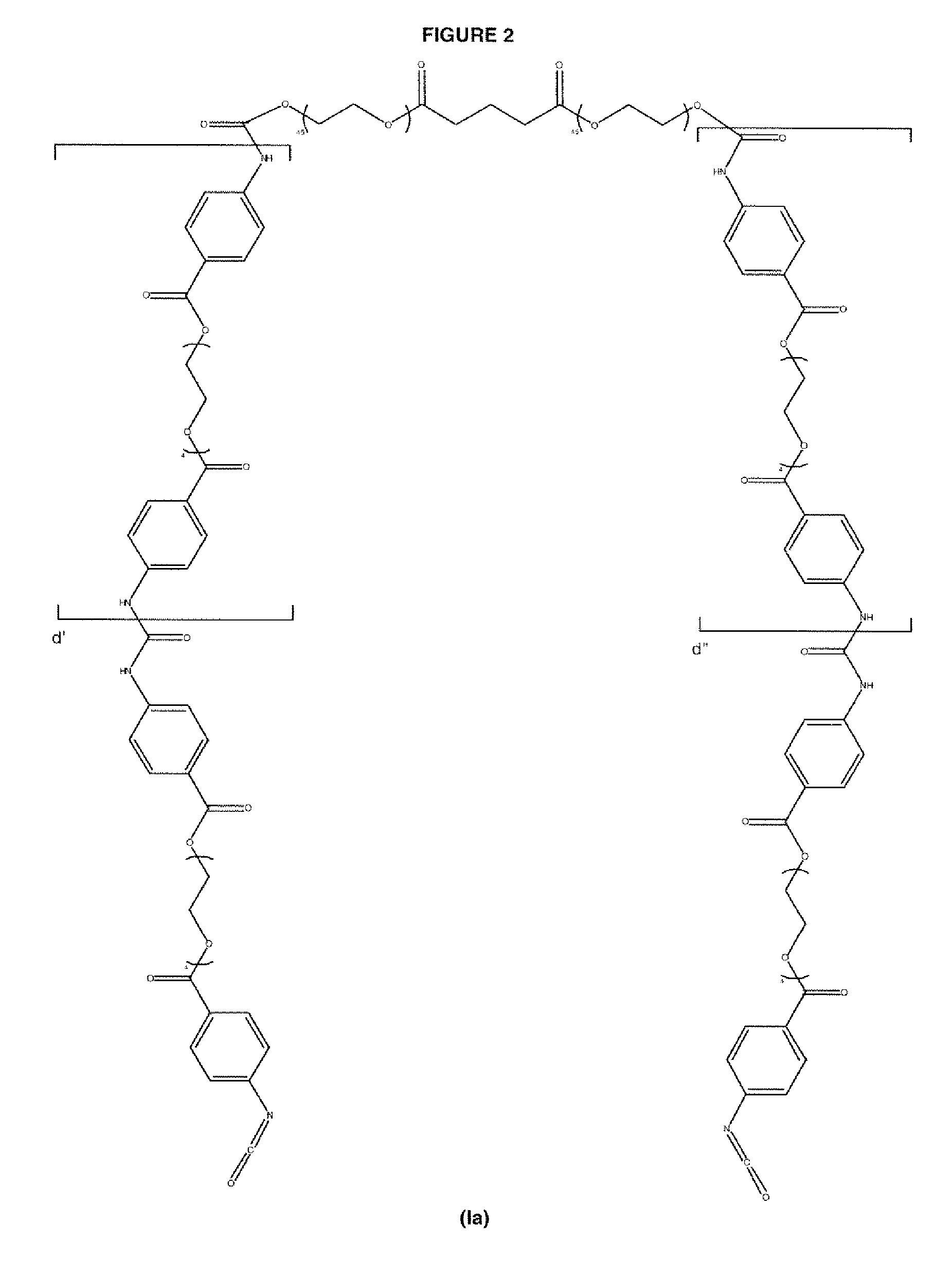Diisocyanate terminated macromer and formulation thereof for use as an internal adhesive or sealant
a technology of diisocyanate and macromer, which is applied in the field of polyisocyanate macromer or mixture, can solve the problems of unsuitable human use of diisocyanate monomers as internal adhesives or sealants, unsuitable small molecule diisocyanate monomers, and undesirable accumulation of water insoluble fragments in the body
- Summary
- Abstract
- Description
- Claims
- Application Information
AI Technical Summary
Problems solved by technology
Method used
Image
Examples
example 1
Preparation of Prepolymers
[0095] Prepolymer B1
[0096] A 10% solution of ethyl acetate was prepared with 1 mol of tetraethylene glycol, 2.75 mol of 4-nitro benzoyl chloride, and 6 equivalents of sodium carbonate. This reaction was carried out with magnetic stirring under nitrogen at room temperature and atmospheric pressure. The di-nitro intermediate:
was next hydrogenated. To the ethyl acetate solution containing the dinitro intermediate palladium catalyst (10% Pd on carbon) was added at 5% w / w with vigorous stirring and a hydrogen sparge. This resulted in the di-amine intermediate:
[0097] The diamine was purified by washing with aqueous sodium bicarbonate and brine, followed by drying over anhydrous magnesium sulfate. This diamine powder was then dried at 50° C. under vacuum for 12 hours. The purity of the diamine was 99.1% by HPLC.
[0098] To prepare the diisocyanate the following procedure was used. In a one liter, three neck flask 68.62 g (0.231 mol) triphosgene and 375 mL of...
example 2
Synthesis of Polyester Polyol R2
[0102] A) Synthesis of Polyester Polyol for Macromer Ia
[0103] 102.8383 g (0.0514 moles) of PEG 2000 was charged to a clean, dry 250 mL 3-neck flask fitted with a nitrogen inlet, dean-stark trap and temperature probe. The contents of the flask were heated to 120° C. and dried under vacuum for 2 hours. Vacuum was released with nitrogen and 2.9138 g (0.02554 moles) of glutaric anhydride and 0.1009 g (0.0005 moles) Tin (II) Oxalate were added. The mixture was heated to 180° C. under nitrogen sparge and held for 2 hours. Vacuum was applied for an additional 21 hours. The polyol was cooled to 80° C. and 3.10 g of silica-citric acid and 1.06 g of diatomaceous earth were added were added. The slurry was stirred for 1 hour at 80° C. under nitrogen blanket. The material was diluted to 40% w / v in toluene then filtered through 2-micron cellulose paper. The solvent was removed to yield a white solid.
[0104] B) Synthesis of Polyester Polyol for Macromer Ib
[0105]...
example 3
Synthesis of 1:1 Macromer Mixture of Ia:Ib wherein d =0.00
[0106] 5.4921 g (1.03×10−3 moles) of the polyol described in example 2A and 2.3974 g (1.07×10−3) of the polyol described in example 2B were charged to a clean, oven dried 1 neck 50 mL flask. The polyol mixture was dried under vacuum at 120° C. for 6 hrs. The solution was cooled to 70° C. and 4.14 g (8.53×10−3 moles) of Prepolymer B1 was added. The mixture was stirred for 20 hours under nitrogen at 70° C. The macromer was cooled and diluted to 75% solids in Dimethyl Isosorbide to yield a viscous amber paste.
PUM
| Property | Measurement | Unit |
|---|---|---|
| viscosity | aaaaa | aaaaa |
| temperatures | aaaaa | aaaaa |
| w/w | aaaaa | aaaaa |
Abstract
Description
Claims
Application Information
 Login to View More
Login to View More - R&D
- Intellectual Property
- Life Sciences
- Materials
- Tech Scout
- Unparalleled Data Quality
- Higher Quality Content
- 60% Fewer Hallucinations
Browse by: Latest US Patents, China's latest patents, Technical Efficacy Thesaurus, Application Domain, Technology Topic, Popular Technical Reports.
© 2025 PatSnap. All rights reserved.Legal|Privacy policy|Modern Slavery Act Transparency Statement|Sitemap|About US| Contact US: help@patsnap.com



